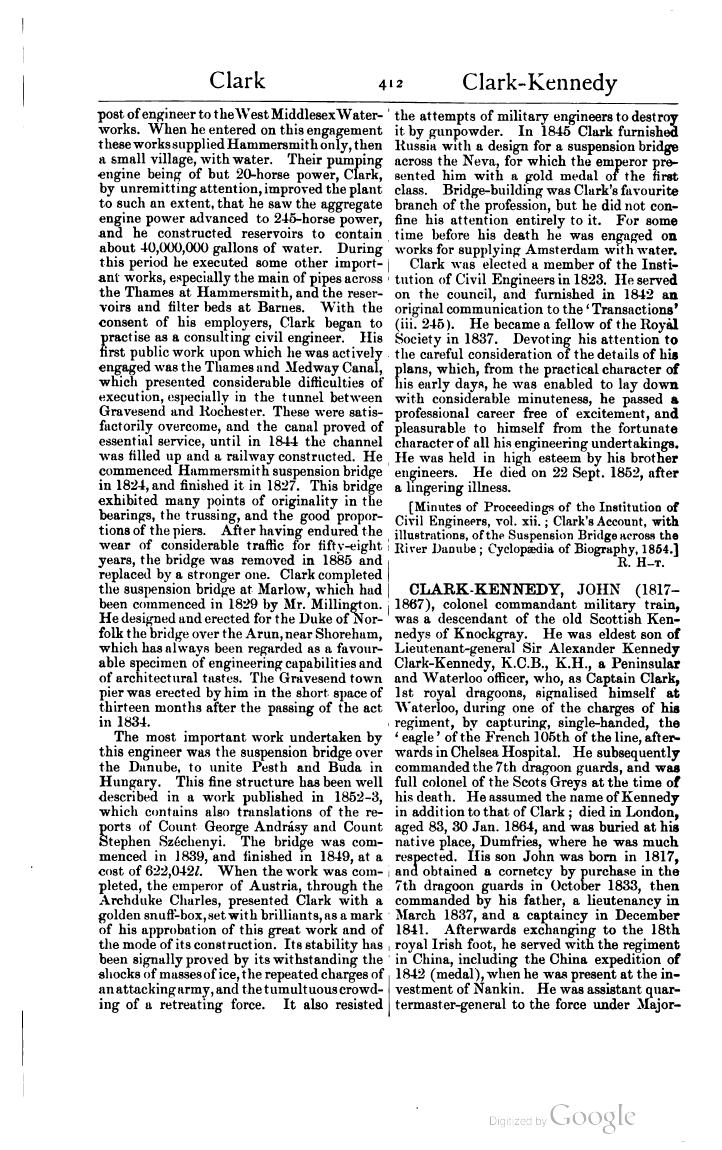post of engineer to the West Middlesex Waterworks. When he entered on this engagement these works supplied Hammersmith onlyii, then a small village, with water. Their pumping engine being of but 20-horse power, Clark, by unremitting attention, improved the plant to such an extent, that he saw the aggregate engine power advanced to 245-horse power, and he constructed reservoirs to contain about 40,000,000 gallons of water. During this period he executed some other important works, especially the main of pipes across the Thames at Hammersmith, and the reservoirs and filter beds at Barnes. With the consent of his employers, Clark began to practise as a consulting civil engineer. His first public work upon which he was actively engaged was the Thames and Medway Cana which presented considerable difficulties of execution, especially in the tunnel between Gravesend and Rochester. These were satisfactorily overcome, and the canal proved of essential service until in 1844 the channell was filled up and a railway constructed. He commenced Hammersmith suspension bridge in 1824, and finished it in 1827. This bridge exhibited many points of originality in the bearings, the trussing, and the good proportions of the piers. After havin endured the wear of considerable traihc git fifty-eight years, the bridge was removed in 1885 and replaced by a stronger one. Clark completed the suspension bridge at Marlow, which had been commenced in 1829 by Mr. Millingon. He designed and erected for the Duke of Norfolk the bridge over the Arun, near Shoreham, which has always been regarded as a favourable specimen of engineering capabilities and of architectural tastes. The Gravesend town pier was erected by him in the short space of thirteen months after the passing of the act in 1834.
The most important work undertaken by this engineer was the suspension bridge over the Danube, to unite Pesth and Buda in Hungary. This fine structure has been well described in a work published in 1852-3, which contains also translations of the reports of Count George Andrasy and Count Stephen Széchenyi. The bridge was commenced in 1839, and finished in 1849, at a Cost of 622,042l. When the work was completed, the emperor of Austria, through the Archduke Charles, presented Clark with a golden snuff-box, set with brilliants, as a mark of his approbation of this great work and of the mode of its construction. Its stability has been signally proved by its withstanding the shocks of masses of ice, the repeated charges of an attackingarmy, and the tumultuous crowding of a retreating force. It also resisted the attempts of military engineers to destroy it by gunpowder. In 1845 Clark furnished Russia with a design for a suspension bridge across the Neva, for which the em ror resented him with a gold medal of the first class. Bridge-building was Clark’s favourite branch of the profession, but he did not confine his attention entirely to it. For some time before his death he was engaged on works for supplying Amsterdam with water.
Clark was elected a member of the Institution of Civil Engineers in 1823. He served on the council, and furnished in 1842 an original communication to the ‘Transactions’ (iii. 245). He became a fellow of the Royal Society in 1837. Devoting his attention to the careful consideration of the details of his plans, which, from the practical character of is early days, he was enabled to lay down with considerable minuteness, he passed a professional career free of excitement, and pleasurable to himself from the fortunate character of all his engineering undertakings. He was held in high esteem by his brother engineers. He died on 22 Sept. 1852, after a lingering illness.
[Minutes of Proceedings of the Institution of Civil Engineers, vol. xii.; Clark’s Account, with illustrations, of the Suspension Bridge across the River Danube; Cyclopædia of Biography, 1854.]
CLARK-KENNEDY, JOHN (1817–1867), colonel commandant military train, was a descendant of the old Scottish Kennedys of Knockgray. He was eldest son of Lieutenant-general Sir Alexander Kennedy Clark-Kennedy, K.C.B., K.H., a Peninsular and Waterloo officer, who, as Captain Clark, 1st royal dragoons, signalised himself at Waterloo, during one of the charges of his regiment, by capturing, single-handed, the ‘eagle’ of the French 105th of the line, afterwards in Chelsea Hospital. He subsequently commanded the 7th dragoon guards, and was full colonel of the Scots Greys at the time of his death. He assumed the name of Kennedy in addition to that of Clark; died in London, aged 83, 30 Jan. 1864, and was buried at his native place, Dumfries, where he was much respected. His son John was born in 1817, an obtained a cornetcy by purchase in the 7th dragoon guards in October 1833, then commanded by his father, a lieutenancy in March 1837, and a captaincy in December 1841. Afterwards exchanging to the 18th royal Irish foot, he served with the regiment in China, including the China expedition of 1842 (medal), when he was present at the investment of Nankin. He was assistant quartermaster-general to the force under Major-
